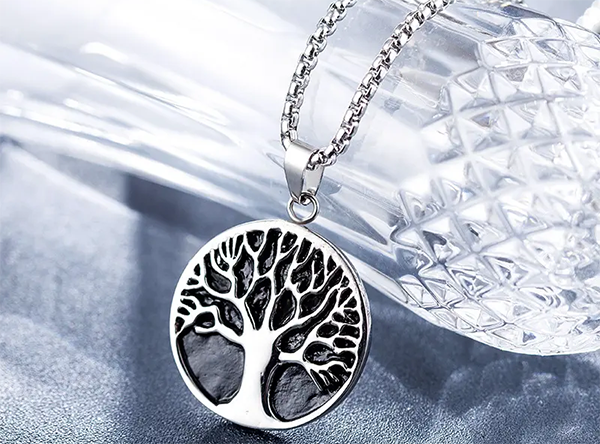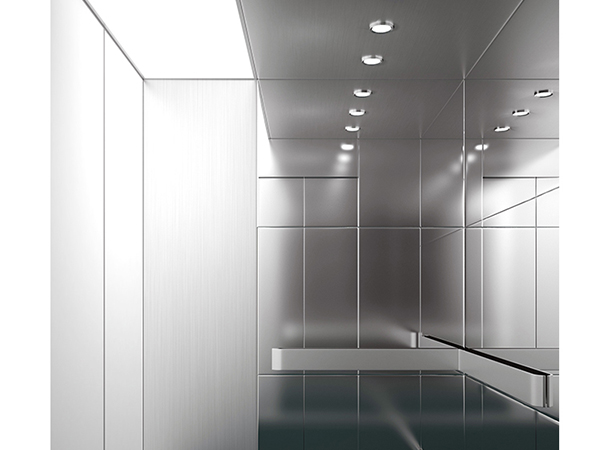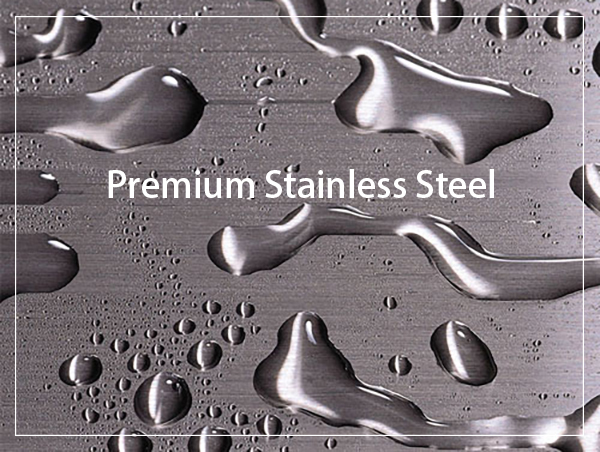
How Important is Stainless Steel in Our
Life?
Nowadays, people can be seen everywhere
with mobile phones or other electronic products in their hands, either looking
down at the screen to play games, or holding their mobile phones while
chatting. Others have skin piercings and wear novel metal jewelry. These scenes
include a variety of portable, functional or decorative, simple or super
complex products, which are usually made of alloy materials, in which stainless
steel plays a very important role.
Eyeglasses - Sturdy Customizable Frames
 316L stainless steel containing 2–3%
molybdenum is an ideal material for making glasses due to its good toughness,
corrosion resistance and hypoallergenic properties, and is used in spectacle
frames, nose bridges, hinges and temples. Manufacturing by stamping is simple
and easy, does not require welding, has high mechanical strength, and can
produce various shapes and styles.
316L stainless steel containing 2–3%
molybdenum is an ideal material for making glasses due to its good toughness,
corrosion resistance and hypoallergenic properties, and is used in spectacle
frames, nose bridges, hinges and temples. Manufacturing by stamping is simple
and easy, does not require welding, has high mechanical strength, and can
produce various shapes and styles.
Smartphones, cameras and camcorders — your everyday companion
Smartphones must meet strict
requirements in terms of performance, ergonomics, durability and aesthetics in
a small package. Continuous use exposes these devices to acids and alkalis
contained in skin oils, salts in sweat, and indoor and outdoor atmospheres.
They must be able to withstand the impact of being dropped or bumped, and they
must also maintain a perfect appearance. Therefore, 316L stainless steel is the
preferred material for the internal and external frames of smartphones. Beauty
is an important aspect of stylish design, and the variety of stainless-steel
surfaces makes it even more attractive.

Manufacturers of other products also
appreciate these properties of stainless steel. Some smartphone cases and many
portable USB battery chargers feature 316L stainless steel frames to protect
them from premature damage due to wear and tear. For cameras and camcorders,
there is a competition between plastic, aluminum and stainless steel materials.
316L has the advantage for camera bodies because it has the best impact
resistance and dent resistance.
Other materials are often used in these
applications, but plastics are brittle, carbon fiber composites are costly, and
aluminum is not strong enough, so these materials are less attractive.
Stainless steel is often the best choice!
Headphones, headsets and microphones – easy to wear and better sound quality
 Headphones, headsets, and microphones
allow people to listen to music without disturbing others and use their phones
anytime, anywhere. Stainless steel is an important component of these items.
Headphones, headsets, and microphones
allow people to listen to music without disturbing others and use their phones
anytime, anywhere. Stainless steel is an important component of these items.
The headband of the headset can be equipped with an ultra-light flexible 316 stainless steel wire mesh frame, covered with foam and enclosed in a removable colored plastic sheath to ensure durability and comfort. In high-end over-ear headphones, 316L stainless steel mesh reduces ambient noise and enables excellent sound reproduction. The one-piece frame of the integrated headphone microphone unit is made of 316L stainless steel and is equipped with a removable plastic cover that opens to reveal the internal components. 316L stainless steel wire mesh effectively protects the diaphragm of the handheld microphone from oral splash and provides better corrosion resistance than other materials. Ultra-fine mesh (0.1 mm diameter) provides the same protection for the earpiece, the microphone connected to the earpiece or the wireless lavalier microphone.
Piercing Jewelry – Beautiful, Hypoallergenic, and Hygienic
 Humans have been wearing jewelry for at
least 35,000 years. Jewelry is used to decorate, confer power and status,
attract attention, dress up and express personality. The custom of wearing
jewelry through skin piercings has been around for a long time and has become
increasingly popular in recent years. The fashion industry offers a wide
variety of earrings, rings and piercing jewelry for the ears, nose, mouth and
other parts of the body, made using various techniques and various materials,
in a wide variety of designs and shapes. The continuous close contact of these
jewelry with the skin or mucous membranes, and the surgical operation of
piercing the skin to wear them will create a great risk of infection.
Therefore, skin piercing jewelry must be corrosion-resistant, hypoallergenic,
durable, and require minimal maintenance and upkeep.
Humans have been wearing jewelry for at
least 35,000 years. Jewelry is used to decorate, confer power and status,
attract attention, dress up and express personality. The custom of wearing
jewelry through skin piercings has been around for a long time and has become
increasingly popular in recent years. The fashion industry offers a wide
variety of earrings, rings and piercing jewelry for the ears, nose, mouth and
other parts of the body, made using various techniques and various materials,
in a wide variety of designs and shapes. The continuous close contact of these
jewelry with the skin or mucous membranes, and the surgical operation of
piercing the skin to wear them will create a great risk of infection.
Therefore, skin piercing jewelry must be corrosion-resistant, hypoallergenic,
durable, and require minimal maintenance and upkeep.

Molybdenum-containing “surgical implant stainless steel” (316, 316L) provides a cost-effective solution to potential problems such as allergic reactions and dermatitis. The inert chromium oxide on the stainless steel surface protects the skin from allergic reactions. Molybdenum improves resistance to localized corrosion and minimizes the release of potential allergens. Other metals such as gold and titanium can also be used, but not only are they expensive, but they themselves can sometimes cause skin problems. In such applications, stainless steels with lower chromium content and no molybdenum should be avoided because of their higher potential for allergic reactions.
Watches – Robust, elegant and precise
 Watches are practical and personal
objects that are perhaps the best example of metallurgical, mechanical and
digital technology combined with artistic creation. From the simplest models to
timepieces in limited edition series, watchmakers use 316 and 316L stainless
steel to protect their watches from the corrosion and shocks of everyday life.
Watches are practical and personal
objects that are perhaps the best example of metallurgical, mechanical and
digital technology combined with artistic creation. From the simplest models to
timepieces in limited edition series, watchmakers use 316 and 316L stainless
steel to protect their watches from the corrosion and shocks of everyday life.
Hardness, corrosion resistance and hypoallergenicity are all important factors in choosing watch materials. Stainless steel has these properties and more. They are suitable for a variety of manufacturing processes and come in many different surface treatments (such as polished, satin, brushed, guilloche, engraved, etc.). The most common applications are wristbands and watch cases. Some parts of high-end watches are made of special alloys containing molybdenum to avoid the impact of magnetic fields on their accuracy. Parts close to the crown, where moisture may enter, are also usually made of 316L stainless steel. In addition, 316L stainless steel is particularly valued for its excellent machining properties and cold forming properties. Cold forming work-hardened materials are used for internal parts that require high hardness for wear and deformation resistance.
Although 440C stainless steel
(molybdenum content up to 0.75%) is less commonly used in watches, its hardness
is still appreciated. Compared with 316 or 316L, it is less resistant to
seawater corrosion and is easier to magnetize, but it is also much cheaper and
is often used as an alternative material to 316 stainless steel for cheap
replicas of luxury watches.
Stainless steel materials have even become a design feature emphasized by marketers. For example, Apple highlights in its advertising the use of 316L stainless steel in its groundbreaking Apple Watch. Rolex touts the superior corrosion resistance that 904L stainless steel cases and straps bring to its dive watches, a highly corrosion-resistant stainless steel grade commonly used in marine applications and industrial process equipment.
Pet Accessories – Strong and Corrosion Resistant
Even for pets, stainless steel is essential. Metal collars and identification tags are exposed to the elements, and the loops to which the leash connects must be strong when a dog suddenly spots a cat. Sometimes collars represent fashion, and stainless steel can help create a beautiful design. Just like humans, pets can experience allergic reactions and need protection. There are a variety of pet accessories available for them and their owners, and 316L stainless steel accounts for the vast majority!

Stainless steel and specialty alloys are
commonly found in the items we wear and carry, whether they are utilitarian,
decorative, or both. This is because these materials maintain their beautiful
appearance, do not cause allergic reactions, and protect sensitive electronic
devices from damage. They can add beauty to these items and increase their
longevity and safety.






